Of the many destinations close to Kolkata for a quick getaway, Bolpur and Santiniketan remain perennial favourites. When visiting Bolpur next time, tread beyond the known and take some time to visit the age-old brick temples adorned with exquisite terracotta work that dot villages and towns within a 30-km radius of Bolpur.
One can visit these magnificent structures following three routes. For the first, it is recommended heading to the temples of Surul, Supur and Itonda.
Temples of Surul
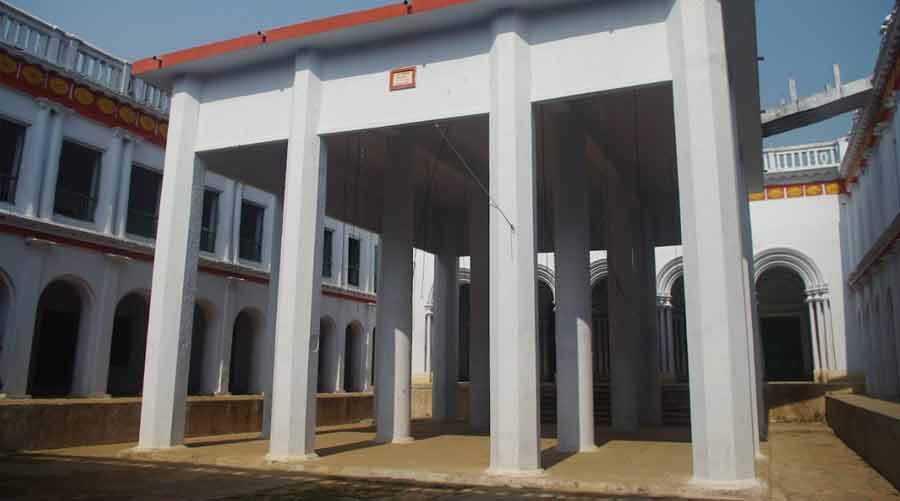
The Surul Rajbari is one of the few well-maintained erstwhile zamindari homes of Birbhum
About 5km west of Bolpur, the Surul Rajbari is one of the few well-maintained erstwhile zamindari homes of Birbhum. In the 18th century, local man Srinivas Sarkar acquired the rajbari and built it up to the structure we see at present. Sarkar made his fortune selling sails for the ships that traded from the busy Saheb Ghat port in Illambazar, about 14km away, when Surul was a commercial residency under the East India Company.
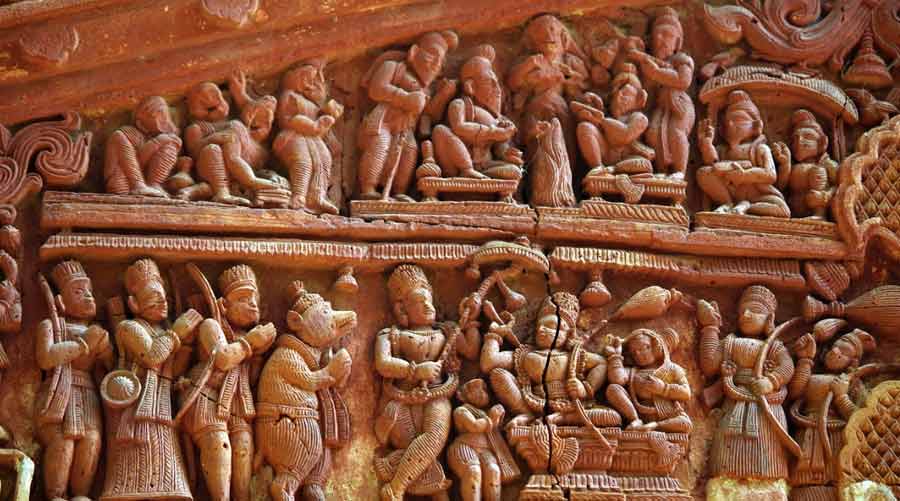
A terracotta panel depicting the court of Ravana at the Lakshmi Janardan Temple, Surul
By the mansion is the 19th-century Lakshmi Janardan temple. The five-pinnacled structure of the temple has intricate terracotta work depicting scenes from the Ramayana. Unfortunately some of these panels have decayed over time, but the surviving ones are just as beautiful to see. Beside the Lakshmi Janardan temple stand the two Rekha-Deul style Shiva temples of the Sarkar family. The most prominent terracotta work here depicts the enthronement of Rama. Interestingly, in the panel, all those assembled to witness the moment are dressed in European attire.
These terracotta temples around the Surul Rajbari were all built by Srinivas Sarkar. Two more temples with exquisite terracotta work stand in the south-western end of the village and are maintained by the descendants of Srinivas Sarkar.
Temples of Supur
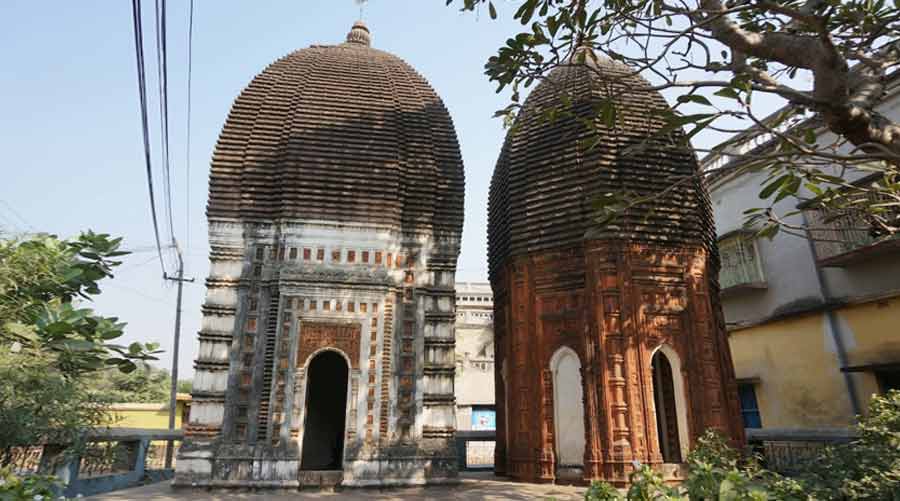
The 18th-century Jora Shiva Temples of Supur are also known as the Jora Mandir of Lalbazar
Just 5km south of Surul is the village of Supur, which was once believed to be part of Kalinga king Suratha’s kingdom.
Among the temples dotting the village is the 18th-century Jora Shiva Temples, also known as the Jora Mandir of Lalbazar. The two Rekha Deul-style temples, one of which has an octagonal structure, are the best example of terracotta art in Supur.
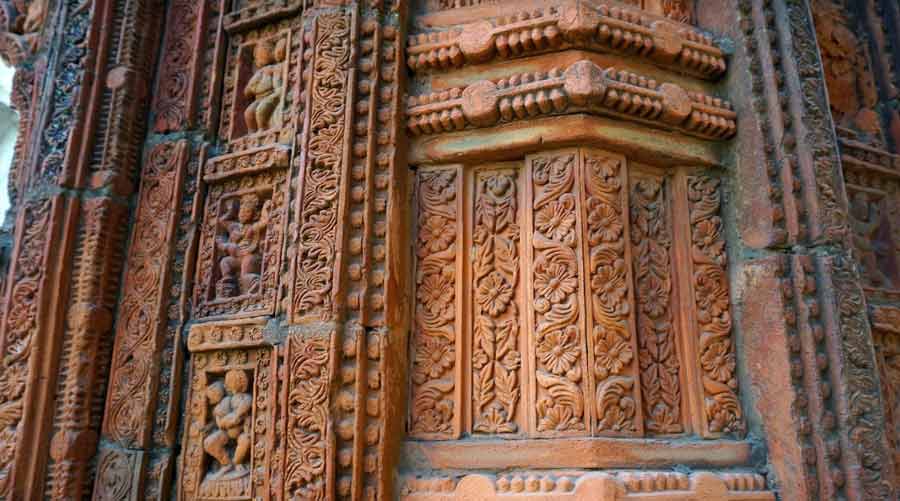
The octagonal Rekha Deul temple has terracotta work on all sides and along with figurines, there are detailed floral motifs in the designs
The octagonal temple has terracotta work on all its sides, and along with human figurines, the panels also have impressive floral motifs. Among the top panels, one can see interesting stories from the Ramayana, such as Rama fighting against his sons Lava and Kusha over the Ashwamedha horse. There are also etchings of gods such as Durga with her family and depictions of war scenes including one that shows soldiers with guns sitting on an elephant and horses.
The only prominent panel in the ridged Rekha Deul is that of Lord Ram and Sita on the throne flanked by Ram’s courtiers.
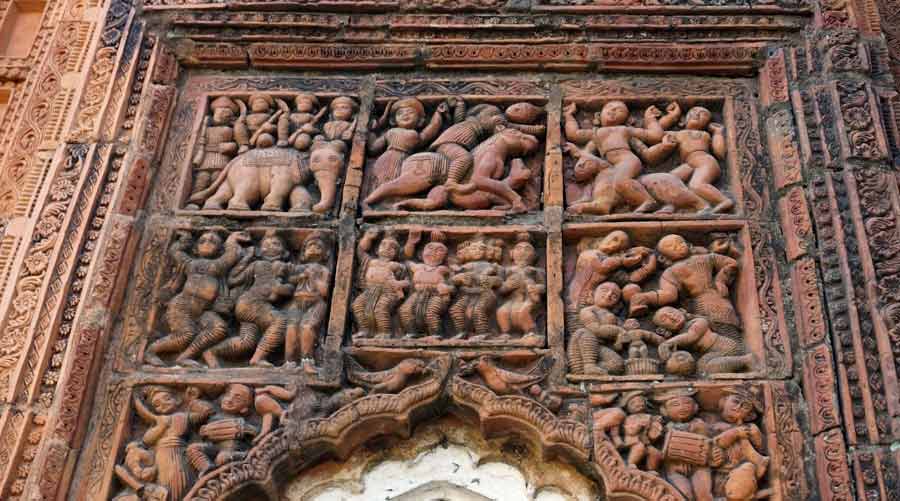
Among the terracotta figurines in the Rekha Deul temples at Surul, one can see some depicting as dressed in European attire
Temples of Itonda
Itonda, or Itanda, is on the other side of Bolpur and about 19.5km from Supur. There are four beautiful temples for visitors to see here.
The first temple is a small south-facing Rekha Deul, built by one Gadadhar Pyne in 1815. The second, is a Pancharatna Shiva Temple, which was built in 1828. Among the terracotta work in the second — some intact and some eroded — the most notable ones are a plaque showing the court of Rama, scenes from the Dasavatar, a severely eroded figurine of goddess Kali in a sari and the figure of a bearded nobleman wearing crown-like headgear.

Itonda’s Sridhar temple has arches with detailed stucco work inside
The third temple, known as the chandni (flat-roofed) Sridhar temple, is a double-storied structure that looks like an old zamindar house. A foundation stone indicates that the year of construction is 1844. The temple has pillars and arches on both floors, along with detailed stucco work. The Pancharatna Shiva temple and the Sridhar temple were both built around 200 years ago by Rasananda Sadhu, who was the last well-known member of the local Sadhu family.
The star attraction of this village, however, is the Jora Bangla-style Kali Temple. The temple was in a perilous condition, but the state archeology department, along with the Santiniketan chapter of Indian National Trust for Art and Cultural Heritage (INTACH), has done a commendable job of renovating it.

A naval war scene etched on a terracotta panel at the Jora Bangla Kali Temple in Itonda
The exquisite terracotta panels of the temples are works of art that paint a picture of life, events and art of the 19th century. In one of the base panels, a naval gunfight plays out between two ships armed with cannons. Other interesting scenes show a lion hunting, soldiers marching with guns and elite noblemen in robes.
There is also mythology-inspired art such as a figure of Devi Chandi sitting on a lion and fighting demons, and Dasvatar and Dasamahavidya motifs. In one motif we see a young Hanuman attacking Surya, who is in his chariot driven by his winged charioteer Arun, the brother of Garuda. The floral design and the vertical friezes on the walls of the temple were masterfully done as well.

